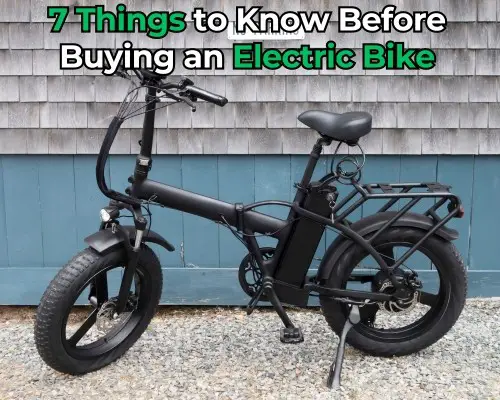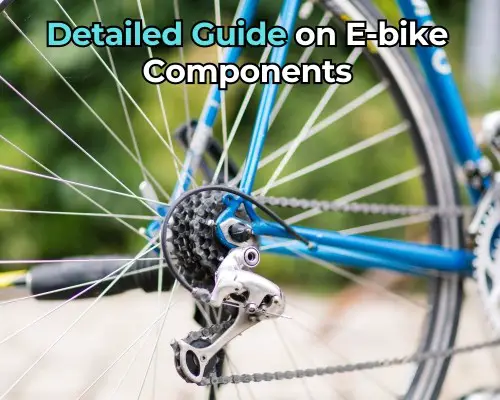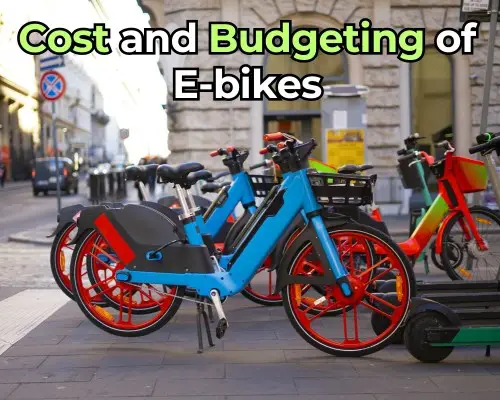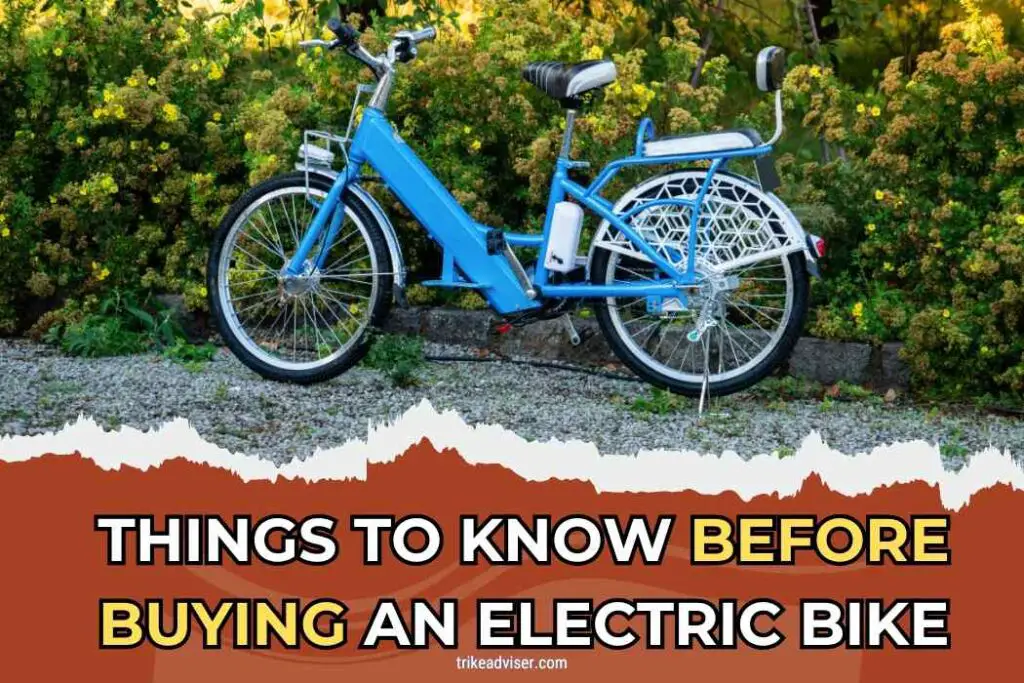Thinking about an electric bike? Smart move. But hold on—don’t rush. Electric bikes can be tricky. They’re not just about picking a color or style.
It’s about making informed choices. They’re pricier, right? And heavier too. Plus, there’s the battery life saga. Will it last on a long commute? And repairs? Not your regular bike shop stuff.
Need to haul it upstairs or onto a train? Consider the weight. Most importantly, how does it ride? Like your regular bike? No, it feels different. Test it. Seriously.
Lastly, think about the law. Yeah, regulations vary. Some places treat them just like bikes, others don’t. Know what you’re getting into. Ready for the journey?
7 Things to Know Before Buying an Electric Bike

1. Speed
Top Speed and Regulations
Navigating e-bike regulations is like decoding your tax return—necessary but tricky. In the U.S., you can rev up to 32 km/h with a robust 500-watt motor. In Europe, you’re looking at a gentler 25 km/h from a 250-watt motor.
Think of your local laws like speed bumps—know them, or you’re in for a rough ride. Want the thrill of speed? Pedelecs can surge up to 45 km/h—make sure you’re strapped in!
Performance
Here’s a tip: think of your e-bike like a new employee. You wouldn’t hire without an interview, right? Test drive different models.
Check acceleration, handling, and braking. It’s about how the bike rides, not just its specs on paper. Does your daily route have hills? Make sure your e-bike can climb them without puffing out.
2. Riding Range
Average Distance
Imagine this: a battery that lasts longer than your phone. Standard e-bikes cover about 100-120 km per charge.
But remember, battery life is like a bar of chocolate—the more you indulge, the quicker it’s gone. Factor in your usage—speed, terrain, and weight all nibble away at your range.
Maximum Range
Dreaming of long scenic routes? Some models promise 350-400 km on a single charge. But let’s ground that—most city riders will find 50-60 km sufficient. It’s like packing an umbrella; hope for the best but plan for the worst.
3. Battery Life
Lifespan
Lithium-ion batteries are the marathon runners of the e-bike world, lasting 2-5 years. But just like any good runner, maintenance is key—regular check-ups extend life. Don’t be left with a dead battery in the middle of nowhere—keep tabs on its health.
Charging Cycles
Consider this: a battery’s lifespan isn’t just about years; it’s about charge cycles. A good one lasts for thousands of charges.
That’s countless commutes and weekend jaunts. Like good habits, the benefits of a durable battery accumulate over time.
4. Motor Power
Wattage Options
More watts don’t just mean more power; they mean more freedom. But they also mean a quicker battery drain. Choose wisely—like picking between a sports car and a sedan. What’s your priority? Speed or sustainability? Balance is key.
5. Charging Infrastructure
Home-Charging
Plug in your e-bike like you do your smartphone—overnight and out of mind. But here’s a pro tip: Avoid leaving it plugged in past a full charge; it’s like overeating, it feels good at first but isn’t healthy in the long run.
Public Charging
Public charging stations are like coffee shops; their numbers are growing. But are they on your route? Check this as meticulously as you check the weather. Being stranded with a dead e-bike is no fun.
6. Maximum Load
Load-Carrying Capacity
Got cargo? E-bikes vary widely, from sleek commuters to bulky cargo bikes. Like choosing a backpack, consider what you’ll carry. Groceries, gear, or children—make sure your e-bike doesn’t buckle under pressure.
7. Noise
Motor and Chain Noise
Listen to your bike. A quiet whirr is not just pleasant, it’s a sign of good health. A noisy chain or motor might be crying out for help.
Preventative care is less costly than major fixes. Treat small noises like early warning signals, not just minor annoyances.
Detailed Guide on E-bike Components Before Buying

E-bikes aren’t just about hopping on and zipping off. It’s a journey of marrying the right technology with your lifestyle. Let’s dive deeper into what makes these machines tick and how to pick the best fit for your adventures.
Motor Types and How to Choose the Right One
Overview of E-Bike Motor Types
- Hub Motors: Picture this: a serene ride through the park with no engine growl. That’s your hub motor. It’s perfect for those who prefer a stealthy, relaxed commute.
- Mid-Drive Motors: Here’s where the muscle kicks in. Located at the bike’s center, these motors offer balanced weight distribution, essential for those who face hills like warriors in battle.
- Crank Drive Motors: For the purists, these motors enhance your pedal power directly, giving that authentic biking feel with every push.
- Brushed Motors: The old guard. Cheaper, yes, but with a charm that appeals to the budget-conscious who are just starting.
- Brushless Motors: The future is here. Smoother, more efficient, and though they may pinch the wallet, they’re worth every penny for the serious rider.
Choosing the Right Motor
- Riding Style: Your terrain is your tale. Choose a mid-drive for mountain treks; a hub motor suits urban sprawls.
- Budget: Think of this as an investment in your daily joy. Match your spending to your need for speed and tech.
- Weight and Frame Size: Never underestimate the feel of the ride. A test ride isn’t just recommended; it’s essential.
- Maintenance: Fancy less fuss? Brushless is your buddy. On a shoestring? Brushed motors will do the job.
Batteries Explained: Types, Lifespan, and Care
Types of E-Bike Batteries
- Lead-Acid Batteries: Think of these as the sturdy old boots you can’t bear to throw out—reliable, but a bit clunky.
- Lithium-Ion Batteries: These are your high-tech sneakers—lighter, faster, and designed for the long haul.
Factors Influencing Battery Lifespan
- Charging Habits: Like snacking, it’s best in moderation. Keep charges between 20-80% to extend battery life.
- Storage Conditions: Treat your battery like fine wine. A cool, dry place maintains its essence.
- Usage Patterns: Heavy loads wear out your battery faster—like sprinting in those high-tech sneakers.
Tips for Maximizing Electric Bike Battery Life
- Customary Support: Normal check-ups anticipate major breakdowns. It’s like going to the dental practitioner but for your bicycle.
- Maintain a strategic distance from Extraordinary Temperatures: Batteries are like us; they incline toward a mellow climate. As well hot or as cold, and they get crotchety.
- Screen Battery Wellbeing: Keep an eye on its execution. Early substitutions anticipate afterward disillusionments.
Braking Systems: Mechanical vs. Hydraulic
Mechanical Disc Brakes
- Preferences: Like old-school jeans—simple, dependable, and simple to settle.
- Drawbacks: They require a bit of elbow oil and normal tune-ups.
Hydraulic Disc Brakes
- Advantages: These are the tailored suits of brakes—sleek, efficient, and low maintenance.
- Disadvantages: Higher upfront cost, but they pay off with performance and less fuss.
Choosing the Right Braking System
- Riding Conditions: Hydraulics for the rugged; mechanical for the relaxed.
- Budget: Balance initial cost against ongoing maintenance. Sometimes, spending more now means saving later.
- Performance: If you crave precision with each stop, hydraulic is the way. For casual rides, mechanical will serve well.
Cost and Budgeting of E-bikes

Choosing to purchase an e-bike isn’t fair choosing another way to commute; it’s grasping a more brilliant, more economical way of life. But some time recently you made the jump, let’s get genuine around the numbers and insider tips to ensure your venture pays off in the long run.
The Real Cost of Owning an E-bike
Purchasing Cost
- E-bike vs. Car: Think $1,000 to $4,000 for a sturdy commuter e-bike versus the hefty $27,000 to $47,000 you might cough up for a car.
Now, if you’re eyeing that sleek, top-tier e-bike priced between $10,000 and $12,000, remember—it’s still a fraction of a new car’s cost.
- Efficiency Savings: Zooming into daily costs, e-bikes are the clear winners. Charging an e-bike costs about $0.04 per mile.
For a regular 32-mile round trip, that’s barely $1.28 a day. Compare that to the $3.20 you’d spend on fuel alone for a car like a Toyota Corolla.
Maintenance Cost
- Annual Expenses: With an average yearly maintenance cost of $754, e-bikes are not just fun but economical.
Cars? They’ll set you back about $1,186 a year. Remember, e-bikes skip the pricey oil changes and frequent part replacements cars need.
- Hidden Perks: Here’s a sweetener—no ongoing costs for licenses, registrations, or mandatory insurance.
Plus, ever circled the block looking for parking? Forget it. Parking an e-bike is as easy and free as pie, saving you up to $345 a year in urban headaches.
Understanding the Warranty and What It Covers
Warranty Insights
- What’s Covered?: Warranty terms are as varied as bike models. A rule of thumb—more expensive bikes tend to have longer and more inclusive warranties.
Think of it as buying peace of mind alongside your bike. Typically, everything from the frame to the battery is protected.
- Mind the Details: It’s not just about having a warranty; it’s about knowing it inside out. Cheaper e-bikes might not cover wear and tear on tires or the chain.
Stick to the maintenance schedule recommended by the manufacturer to keep your warranty intact and your bike in top shape.
Tips for Finding the Best Deals on E-bikes
Market Navigation
- Refurbished Gems: Consider a refurbished model for value. These bikes often come with a solid warranty, just like new ones, but at a fraction of the cost. It’s like buying a nearly new car—the same performance, much better price.
- Haggle Away: When eyeing a used e-bike, channel your inner negotiator. Minor cosmetic damage? Use it to lower the price. Just make sure the essentials—battery, motor, frame—are in good shape.
Financial Strategies
- Know the Market: Arm yourself with knowledge. What’s the going rate for the e-bike model you’re after? Knowing this will sharpen your bargaining power and prevent overspending.
- Seasonal Smart Shopping: Timing is crucial. Shop during off-seasons or just as new models hit the market. Retailers often offer significant discounts to clear older stock.
- Flexible Financing: Tight budget? Look for financing options. Some retailers offer payment plans that make an e-bike purchase more digestible.
Legal and Safety Considerations for E-Bike

Choosing an e-bike is energizing, but it’s like marking up for a marathon — you would like to know the course and get ready fittingly. Let’s peel back the layers of lawful and security measures with a more profound plunge into what it truly implies to possess and work an e-bike dependably.
Navigating E-bike Laws and Regulations
Deep Dive into Classification
- Understanding Classes: E-bikes are split into three classes. Think of Class 1 and 2 as your reliable city runners — perfect for daily commutes with a throttle-free experience in Class 1.
Class 3 is like the sports car of e-bikes, racing up to 28 mph and often requiring the same legal respect as motorbikes.
- Local Laws: Here’s where it gets tricky. Your zip code dictates your ride. Some areas treat Class 3 e-bikes like mopeds, demanding registration and licenses.
Dive into local transport websites or a quick visit to your city’s transportation department can save you from fines or even bike confiscation.
Registration and Licensing Specifics
- Check Twice: Especially with a Class 3, it’s akin to getting a new pet — there might be a license involved.
And just like pets, if you’re not compliant, there are consequences. Always verify what your local jurisdiction requires to stay on the right side of the law.
Safety Features and Gear for E-bike Riders
Gear Up Right
- Helmet: Not just any helmet—a bike helmet meant for high speeds. Look for those that meet ASTM or NTA specifications; they’re designed to protect at speeds typical to e-bikes.
- Visibility Tactics: It’s not just about lights; it’s about the right lights. Ensure your e-bike is equipped with high-lumen LEDs. Reflective clothing should be on your shopping list, too. Think of it as your nighttime armor.
Pro Tips for Protective Gear
- Smart Apparel: Invest in specialized e-biking apparel. Materials that offer protection without sacrificing comfort or mobility can enhance your ride quality and safety.
- Maintenance Matters: Like every high-performance machine, your e-bike demands normal check-ups. This isn’t almost about fixing a free jolt; it’s almost guaranteeing your ride is secure.
Regular support checks can anticipate accidents—treat it as fundamentally as you’d a car’s brake benefit.
Insurance for E-bikes: Do You Need It?
Evaluating the Need
- Mandatory or Optional?: Depending on your e-bike’s class and local laws, insurance might be more than just a good idea—it might be the law. But even if it’s not compulsory, consider the potential costs of not having it.
- Investment Protection: Your e-bike is not just a vehicle; it’s an investment. In cities, where bike theft is as common as pigeons in a park, having theft coverage can give you peace of mind.
Damage or liability coverage? That’s equally important. Accidents can come with hefty bills if you’re found at fault.
Comprehensive Coverage Choices
- Full Spectrum Coverage: Look for policies that cover theft, damage, and liability. Make sure the policy details align with your typical use and risks. Don’t overlook personal injury protection—it could be crucial if you’re involved in an accident.
- Navigating Policies: Continuously studied the fine print. Protections for e-bikes can be as complex as auto protections.
Know what you’re marking up for to maintain a strategic distance from shocks after you make a claim.
Exploring the legitimate and security viewpoints of e-bike possession might feel overpowering, but with the correct information and arrangements, you’ll guarantee your e-biking encounter is both exciting and secure.
Think of each control and security tip as a checkpoint in your marathon—there to guarantee you reach the wrap-up line securely and joyfully.
As an Amazon Associate, I earn from qualifying purchases, at no additional cost to you. Read Our Affiliate Disclosure.

